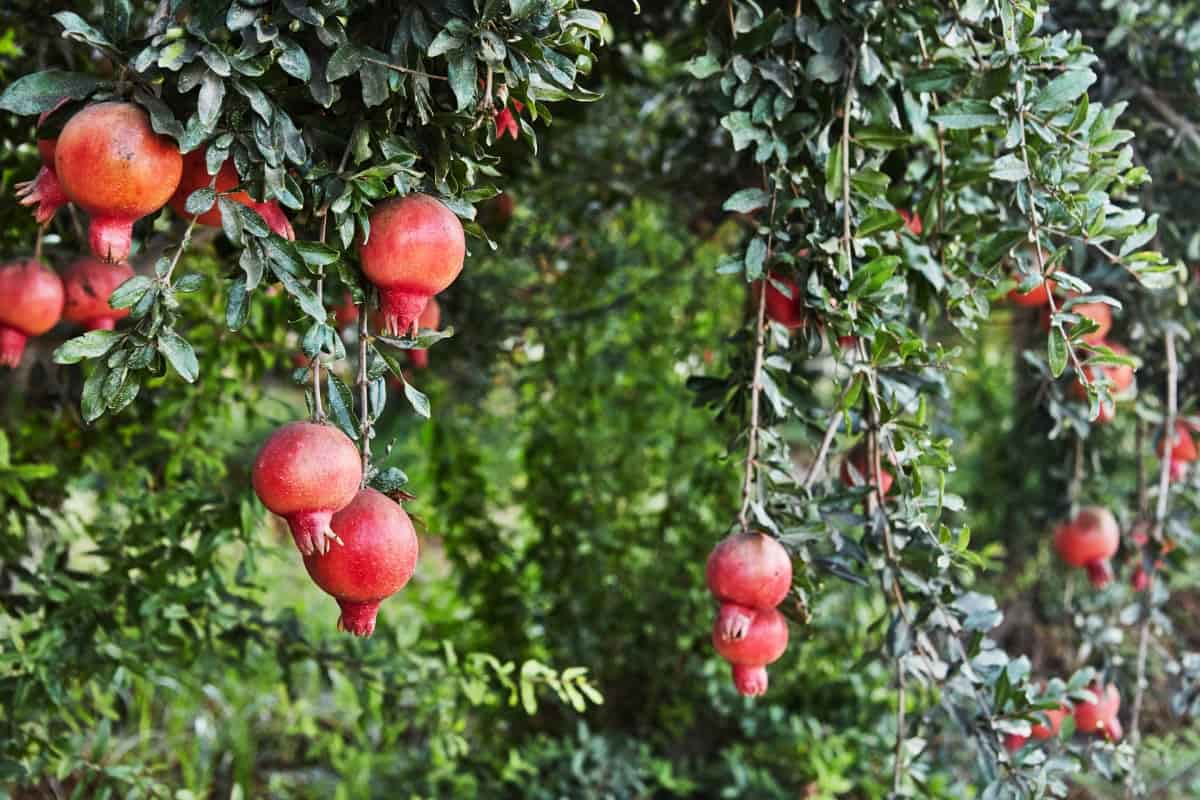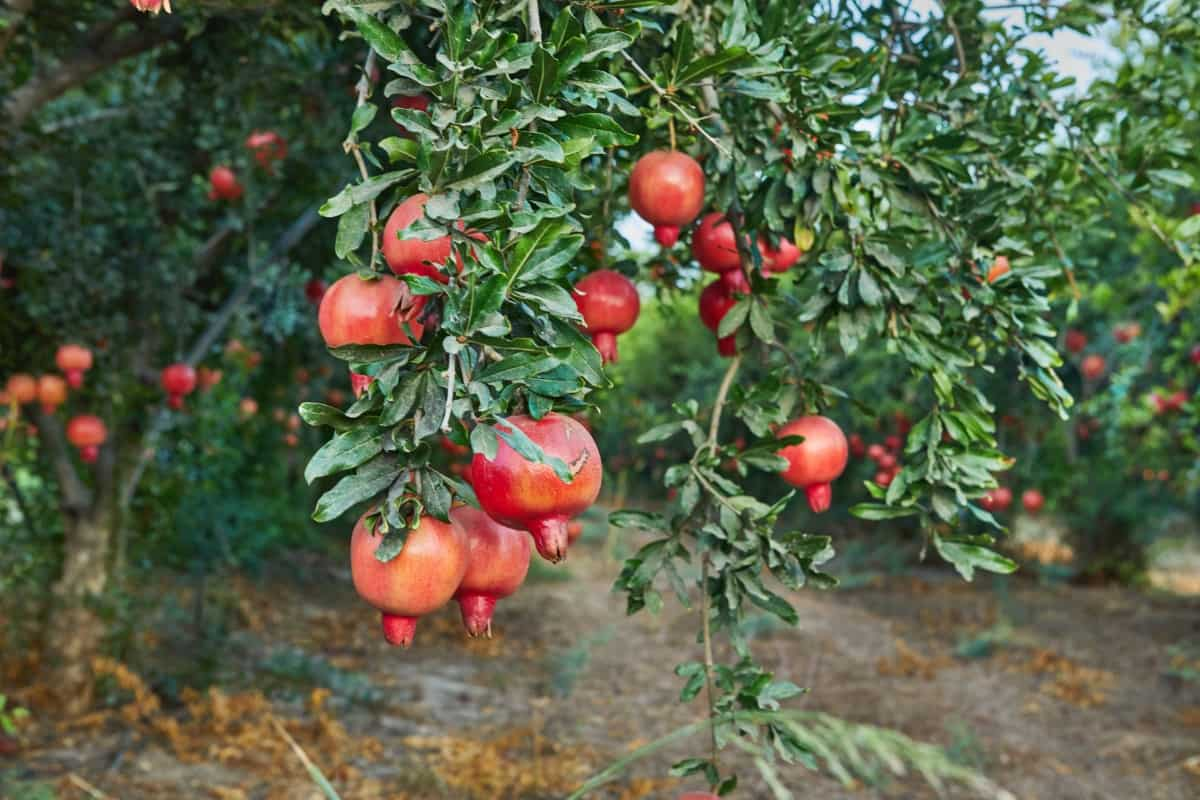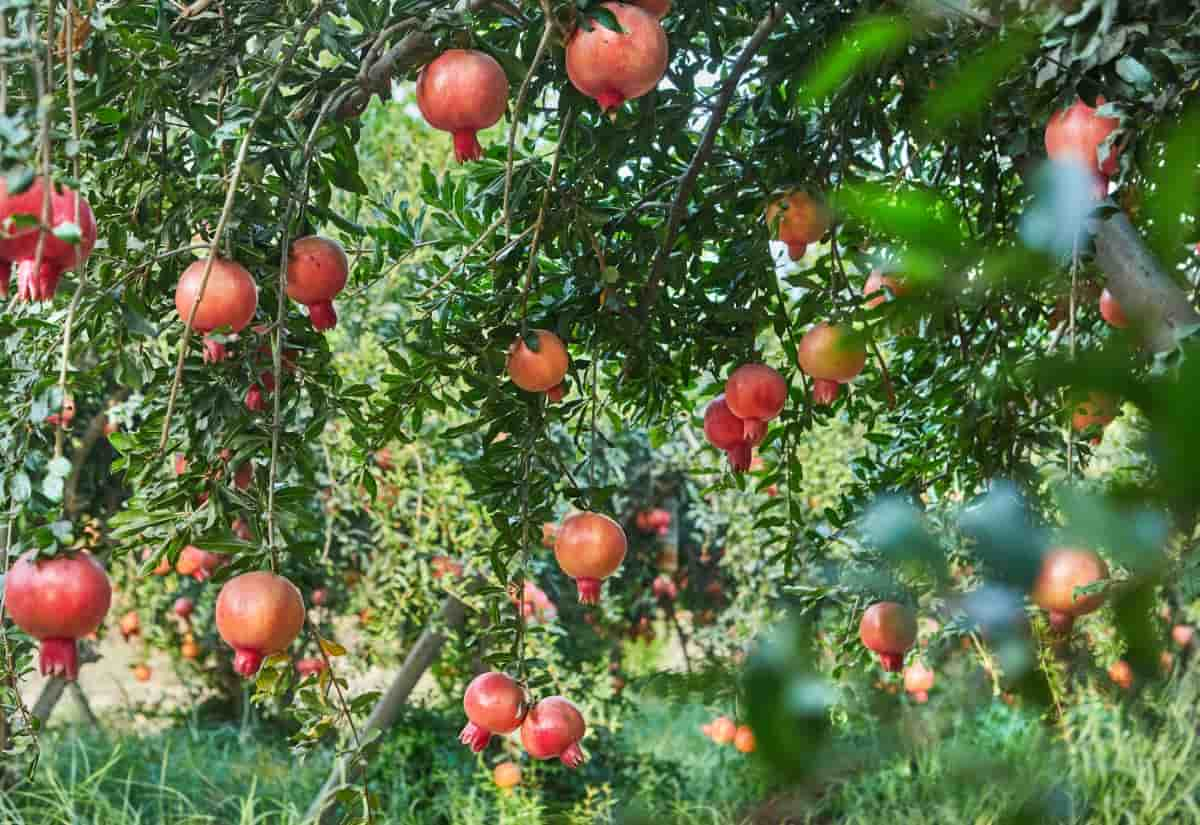Pomegranate tree blooming issues can be frustrating for growers, leading to reduced fruiting and yield. Understanding the factors affecting fruiting problems and implementing appropriate remedies is crucial for enhancing pomegranate tree yield. In this blog, we’ll explore ten reasons why pomegranate trees may not be blooming and fruiting, along with effective treatment solutions.

10 Reasons Why Pomegranate Tree is Not Blooming and Fruiting
Insufficient Sunlight
Pomegranate tree blooming issues may arise due to inadequate sunlight. Ensure your tree receives at least four to eight hours of direct sunlight daily to promote flower formation and fruit set. Consider trimming nearby trees or structures that may be blocking sunlight.
Increasing Sun Exposure
To address pomegranate fruiting problems caused by insufficient sunlight, strategically prune surrounding foliage to allow more sunlight to reach the tree. Additionally, consider transplanting the tree to a sunnier location if possible. Adequate sunlight is crucial for photosynthesis and overall tree health.
Pruning for Light Penetration
Enhancing pomegranate tree yield involves proper pruning techniques. Remove overcrowded branches to improve air circulation and light penetration throughout the canopy. This encourages the development of healthy blooms and fruits. Pruning should be done during the dormant season to minimize stress on the tree.
Improper Watering
Watering tips for pomegranate trees include maintaining consistent moisture levels in the soil, especially during flowering and fruiting stages. Inadequate or excessive watering can hinder bloom and fruit development. Use a moisture meter to screen the soil moisture levels and adjust watering accordingly to keep the soil evenly moist but not waterlogged.
Adjusting Watering Schedule
To address pomegranate tree blooming issues related to improper watering, adjust your watering schedule based on environmental conditions and the tree’s needs. During hot, dry periods, increase watering frequency and reduce it during cooler, rainy spells. This helps maintain optimal soil moisture levels for healthy blooming and fruiting.
Implementing Efficient Irrigation Systems
Enhancing pomegranate tree yield can be achieved by installing drip irrigation to deliver water directly to the root zone. This ensures efficient water usage and minimizes the risk of water-related problems such as root rot or runoff. Monitor soil moisture regularly to fine-tune irrigation schedules.
Nutrient Deficiency
The pomegranate tree care guide emphasizes the importance of proper fertilization to prevent nutrient deficiencies. Apply a balanced fertilizer mixture for fruit trees in early spring before new growth begins. This provides essential nutrients like nitrogen, phosphorus, and potassium to support healthy bloom and fruit development.
Soil Testing and Fertilization
To address nutrient deficiencies affecting pomegranate tree blooming and fruiting, conduct a soil test to identify any imbalances or deficiencies. Based on the results, amend the soil with organic or synthetic fertilizers to correct nutrient levels. Follow fertilizer application instructions carefully to avoid over-fertilization, which can harm the tree.
Organic Nutrient Amendments
Enhancing pomegranate tree yield can be achieved through the use of organic nutrient amendments such as compost, aged manure, or organic mulches. These materials gradually release nutrients into the soil, improving soil structure and fertility while promoting healthy bloom and fruit production. Apply organic amendments annually in spring or fall.
In case you missed it: Bacterial Blight in Pomegranates: Management and Control Measures

Incorrect Soil pH
The pomegranate tree care guide highlights the importance of maintaining a slightly acidic soil pH between 5.5 and 7.0 for optimal growth and fruit production. Conduct a soil pH test and adjustments if necessary. Add lime to raise pH or elemental sulfur to lower pH, following package instructions carefully.
Testing Soil pH
To address pomegranate tree blooming issues related to soil pH, regularly test the soil using a pH meter or testing kit. Aim for a slightly acidic pH between 5.5 and 7.0, as alkaline or acidic soil can affect nutrient availability and overall tree health. Adjust soil pH as needed with appropriate amendments.
Adjusting Soil pH Levels
Enhancing pomegranate tree yield requires maintaining the optimal soil pH range of 5.5 to 7.0. Adjust soil pH levels as necessary using agricultural lime to raise pH or elemental sulfur to lower pH. Incorporate amendments into the soil according to package instructions and retest soil pH periodically to ensure it remains within the desired range.
Pest and Disease Infestation
Pomegranate tree pests and diseases can hinder blooming and fruiting. Common pests include aphids, scale insects, and fruit flies, while diseases like fungal infections and bacterial blight can also affect tree health. Monitor the tree frequently for signs of infestation and take appropriate measures to control them.
Identifying Common Pests and Diseases
To address pomegranate tree blooming issues caused by pests and diseases, familiarize yourself with common culprits such as aphids, scale insects, fungal infections, and bacterial blight. Frequently inspect the tree for signs of infestation or disease, such as distorted leaves, sticky residue, or mold growth, and take prompt action to mitigate the problem.
Integrated Pest Management (IPM)
Enhancing pomegranate tree yield involves implementing IPM strategies to control pests and diseases efficiently while minimizing environmental impact. This may include using natural predators, beneficial insects, traps, or horticultural oils. Rotate control methods and monitor pest populations regularly to prevent infestations.
Environmental Stress
Pomegranate trees are susceptible to environmental stressors such as extreme temperatures, drought, or strong winds, which can inhibit blooming and fruiting. Provide adequate protection and care during periods of environmental stress to support tree health and productivity.
Mitigating Temperature Extremes
To address pomegranate tree blooming issues caused by temperature extremes, protect against frost events or heatwaves. Cover young trees with frost blankets or shade cloth in winter and provide shade during hot summer days. Mulch around the base of the tree to insulate roots and regulate soil temperature.
Protecting Against Wind Damage
Enhancing pomegranate tree yield involves protecting the tree from wind damage, which can disrupt blooming and fruit sets. Erect windbreaks or plant hedgerows to shield the tree from prevailing winds. Securely stake young trees to prevent them from leaning or breaking in strong gusts.
Poor Pruning Practices
The pomegranate tree care guide emphasizes the importance of proper pruning techniques to maintain tree health and productivity. Avoid over-pruning, which can remove too many flowering or fruiting branches, and instead focus on selective pruning to improve structure, airflow, and light penetration.
Pruning for Health and Productivity
To address pomegranate tree blooming issues, adopt proper pruning practices to promote tree health and productivity. Remove dead, diseased, or crossing branches to improve airflow and reduce the risk of pest and disease infestations. Prune selectively to encourage new growth and fruit production.
Seasonal Pruning Guidelines
Enhancing pomegranate tree yield requires following seasonal pruning guidelines. Prune dormant trees in late winter or early spring before new growth begins, focusing on removing dead or damaged wood and shaping the canopy. Avoid pruning during the active growing season to minimize stress on the tree.
Lack of Pollination
Pomegranate tree blooming issues may result from inadequate pollination, especially in self-pollinating varieties. Encourage pollinator activity by planting bee-friendly flowers nearby or installing beehives in the vicinity. Consider hand pollination techniques to ensure thorough pollination and maximize fruit set.
Encouraging Pollinator Activity
Enhancing pomegranate tree yield involves attracting pollinators such as bees, butterflies, and hummingbirds to the field. Plant various flowering plants that flower throughout the crop season to provide food and habitat for pollinators. Avoid using pesticides that can harm beneficial insects.
Hand Pollination Techniques
To address pomegranate tree fruiting problems caused by poor pollination, consider hand pollination techniques. Use a small cotton swab to transfer pollen from one flower to another, ensuring thorough pollination and fruit set. Hand pollination is especially useful for self-pollinating varieties or in areas with limited pollinator activity.
In case you missed it: How to Control Pomegranate Pests Naturally: How to Get Rid of Them with Natural and Organic Treatment

Age and Maturity of Tree
Pomegranate tree growth stages play a significant role in blooming and fruiting. Young trees may take several years to reach maturity and produce abundant blooms and fruits. Be patient, and give proper care and maintenance to support the tree’s development and eventual fruit production.
Understanding Blooming Cycles
Enhancing pomegranate tree yield requires understanding the tree’s blooming cycles. Pomegranates typically bloom in spring, with fruits ripening in late summer to fall. Familiarize yourself with the specific blooming patterns of your tree variety to anticipate and support optimal bloom and fruit production.
Patience with Young Trees
To address pomegranate tree blooming issues, exercise patience with young trees as they establish and mature. It may take several years for a newly planted tree to reach full fruit-bearing potential. Provide consistent care, including proper watering, fertilization, and pruning, to support healthy growth and development.
Rootstock Incompatibility
Pomegranate tree blooming issues may arise from rootstock incompatibility, especially in grafted trees. Select compatible rootstocks for grafting to ensure successful union and optimal tree health. Consult with a nursery or horticulture expert for guidance on choosing appropriate rootstocks for your specific growing conditions.
Selecting Compatible Rootstocks
Enhancing pomegranate tree yield involves selecting compatible rootstocks for grafting purposes. Choose rootstocks that are well-adapted to your soil type, climate, and desired tree size. Consider disease resistance, vigor, and compatibility with the desired scion variety when selecting rootstocks for grafting.
Grafting Techniques
- Employ proper grafting techniques to ensure a successful union between the scion and rootstock.
- Use sanitized, sharp tools to make precise cuts and align the vascular tissues of the scion and rootstock.
- Protect the graft union with grafting wax or tape to prevent desiccation and infection.
In case you missed it: Blossom Fruit Rot in Bottle Gourd: 100% Effective Treatment and Control Solutions

Conclusion
Addressing pomegranate tree blooming and fruiting problems requires careful attention to various factors such as sunlight, watering, fertilizing, soil pH, and environmental stress. By following a comprehensive pomegranate tree care guide, including proper pruning, pollination, and pest management techniques, growers can optimize fruit production and ensure healthy tree growth throughout its maturation stages.
- Deworming Schedule for Dogs/Puppies: A Beginners Guide
- How to Prevent and Control Parasites in Goats
- Beneficial Insects in Pest Management
- Natural Solutions for Pest Control in Flower Gardens
- Types of Fungicides Used in Agriculture
- Common Issues in the Fruit Development Stage of Pomegranate Farming
- Fruit Development Issues in Papaya: Easy Solutions and Treatment
- Soil-Borne Diseases and How to Protect Your Plants
- Practices to Prevent Disease Spread in the Garden